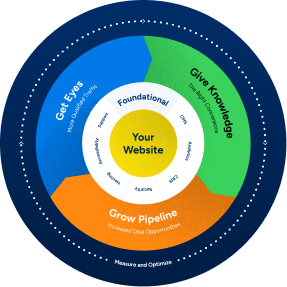Only a few years ago, you could have still made the argument that offline marketing channels were still relevant and could directly impact consumer behaviors. However, with constant internet usage up by 5% over the last three years, it is becoming clearer to professionals in the marketing field that online marketing should be the primary focus.
Looking for a digital marketing expert to boost your online visibility? We can help.
With online marketing gradually entering the spotlight, it’s crucial for marketing professionals to understand how to effectively connect with their target demographic and tap into the ever-elusive marketing achievement of placing the perfect content in the right place at the right time so as to maximize return on investment. Luckily, marketing professionals aren’t making these decisions in the dark. Websites and online platforms generate endless reams of relevant data revealing consumer behaviors. It’s within this data that marketers can find the answer to any question they might need to ask themselves in order to improve existing marketing initiatives or design new campaigns.
In this blog, Boston-based digital marketing agency GoingClear explores how to use data analytics, especially those tracked by the Google Analytics platform, to formulate an effective marketing strategy that maximizes your website’s SEO performance.
The Data You Need Is Already Being Generated By Your Online Digital Assets and Channels
You might be asking yourself where you should even start – do you need to buy the data necessary to make informed decisions? Is this data somewhere already, just waiting for you to stumble across it?
The good news is, generally, any accounts you currently own or maintain are already generating the data you need. The online interfaces for the following online assets generally include access to visitor behaviors and metrics you’ll need to understand in the long run:
- Website and associated blog
- Business’s social media profiles
- Branded online assets, content, and advertising media
Sourcing Effective Data from Google Analytics
While the data collected by the various platforms that host your website or social media pages can be useful, few platforms provide as valuable a trove of information as the Google Analytics platform. As long as you are the site owner and you can properly deploy the necessary tracking codes to your online assets, you can register your website and assets with the Google Analytics platform and track key performance metrics you’ll need during the planning and strategizing process. Once you’ve initiated your Google Analytics account, you’ll want to focus on the three primary categories of data you can glean from the tool.
Audience – Do Your Demographics Match Up?
In the audience section of Google Analytics, users can drill down into a very detailed analysis of user demographics. You can create very detailed segmentation based on age, gender, geographic location, interests and related data fleshing out the general characteristics of visitors to your online assets. Prior to going live with your company and your brand online, you likely would have established a baseline target audience for the products or services you provide, so the analytical breakdown here helps to determine if you’re reaching your target audience, and if not, then what audience you are attracting to the brand.
Acquisition – The Paths Leading Back to Your Brand
In order to make informed marketing decisions that we’ll discuss in more detail below, it’s important to understand how the traffic that is frequenting your websites and online assets are arriving to your pages. Your acquisition channels allow you to track traffic sourced from search engines, social media sites, sponsored content posted on other websites, or any backlinks you have in place. It also informs you what other sites see your brand as a useful source of information and subsequently quote your content or link back to your pages.
Behavior – What Visitors Are Doing On Your Page
Landing pages and other content across your website should all have very specific roles to play across your brand. In the behavior section of Google Analytics, you can actually determine what visitors are doing on your site once they’ve landed. Are they clicking on your calls to action? Are they immediately bouncing from the site, or are they taking the time to follow the carefully customized buyer’s journey you’ deployed on your site. .
How to Put the Analytical Data to Work For You Via a Strategic Marketing Plan
The data insights discussed above, which can all be expanded upon to provide extremely detailed templates of information, can in turn be used to create the foundations of your marketing strategy or tweak an existing marketing plan.
Knowing Where to Focus Your Advertising and Marketing Efforts
Taking a deep dive into both the audience and acquisition analytics, a marketing team can develop a very clear roadmap for an inbound marketing strategy. For example, you might find that social media channels are naturally filtering traffic back to your website with minimal content posts, but you’re not capturing as many leads from Google as you would like. From this, your marketing team could choose to ramp up a Google Ads campaign honed in on your page’s SEO. Additionally, since they are reaching their target audience organically on social media, increasing the advertising in that venue might help to maximize the social media inbound channel and improve search engine performance as well.
Changing Up Your Marketing Material to Better Hone In On Your Target Audience
With as much effort as you’ve put into the search engine optimization of your website behind the scenes, it’s crucial that your off-page marketing efforts match up in order to maximize your page ranking in search results. You can see whether or not your marketing efforts are properly calibrated by digging into your demographic analytics. If they show that your current advertising efforts are attracting the wrong demographic, your marketing team will need to use that information to reshape the advertising to better align with your SEO and capture the proper target audience.
Bounce Rates and Non-Conversions Might Indicate Weak and Ineffective Content and Calls-to-Action
If the analytics show a significant lack of engagement on your landing pages, with bounce rates outside of your target range or high traffic and minimal conversions, this is a clear indicator that your content needs to be reworked to better capture and maintain the attention of visitors to your website. Similarly, determining your conversion rates for each landing page, and comparing it with how closely aligned the average visitor is with your target audience, you can tweak marketing language in your calls to action to better meet the expectations of the customers who are visiting, while simultaneously improving your off-page backlinks and sponsored content to increase traffic that is most likely to be within your target demographic.
Boston’s Premier Digital Marketing Agency Wants To Take a Deeper Dive Into Your Brand’s Analytics
- In this blog, GoingClear has only scratched the surface of the relationship between SEO and data analytics. From our offices in Boston, our team of SEO experts can work with your team to dig deep into your online analytics. We’ll help your brand determine how effective your current marketing campaigns are, and then help you to structure a more effective and informed data-driven marketing campaign. To learn more about these and other services on offer by our digital marketing agency, reach out to a GoingClear client manager today.

